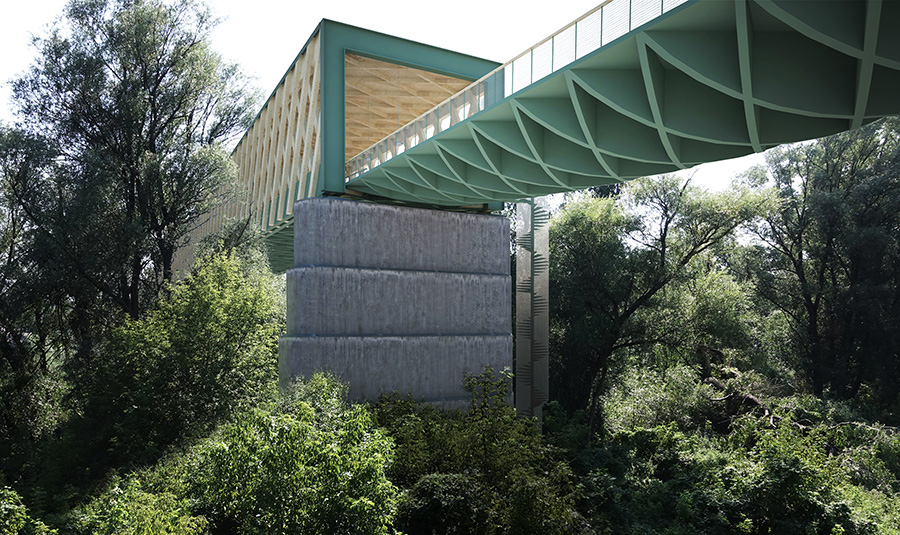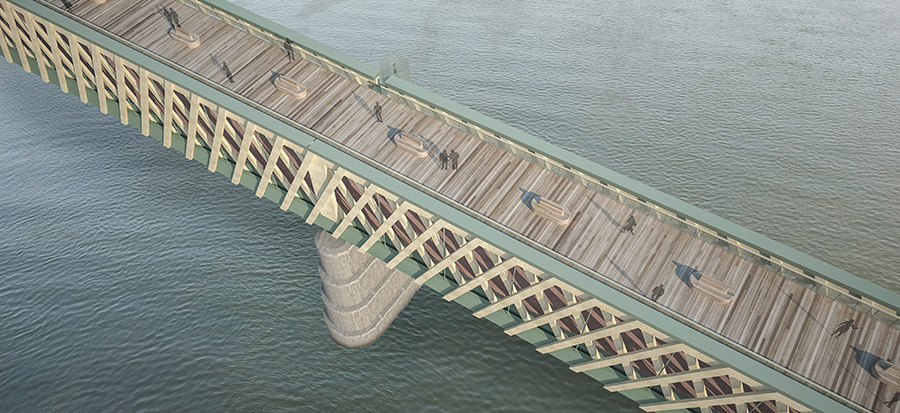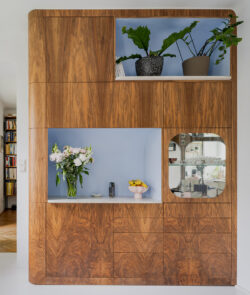Cycle bridge
Competition 2017 | A hybrid timber-steel structure for a pedestrian/cycle bridge over the Vistula in Warsaw | Team: lead designer Jan Strumiłło, engineer Szymon Miklin, Jan Dybowski, Zuzanna Siedlecka, Michał Jońca, Jan Libera, Krzysztof Ścibiorski | Scroll down for full text









Idea
1.1 Basic concept
We propose a hybrid timber-steel bridge resting on simple concrete supports and conrete abutments shaped as sloping arcades. The proposed bridge has six spans: four main spans and two short abutment spans. We placed the spans between five supports and two abutments, both of which form long access ramps. The supports are oval in plan and divide the 450 m distance between the riverbanks into four parts of equal 100 m length with the remainder split unevenly between the two short extreme spans. In our opinion, this provides optimal visual harmony in all views including the proposed bridge and the neighbouring structures. Such positioning of bridge supports reflects the principles used in the majority of Warsaw’s bridges.
1.2 Kierbedź bridge reference
The proposed main spans are lattice girder trusses supported at both ends. Thus, the new pedestrian bridge references the steel truss Kierbedź Bridge which used to connect Warsaw’s Old Town and Praga district until 1944, when it was destroyed by retreating German forces. The Kierbedź Bridge had a strong presence in pre-war Warsaw iconography. It was our intention to design a bridge of a similar horizontal silhouette and an instantly recognizable structure.
1.3 Innovations
Our design brings the large lattice girder truss back to Warsaw’s riverfront: a defining visual element that has long been missing in this area. We decided to give it a modern form in order to avoid literal quotes from the past. Our idea is not to rebuild the Kierbedź Bridge or to copy any extant timber bridge – instead we use these inspirations as starting point to develop our own concept. Our main innovations are splitting cyclist and pedestrian traffic on two levels, using narrowing and curvature to create a spatial climax in the middle and the combination of two modern materials: steel and glulam timber.
1.4 Traffic separation
Cyclists will use the lower bridge platform riding on a flat surface, protected from rain and snow. Pedestrians will be able to climb to the top of the bridge following a series of gently sloping ramps. They can reach all the way to the bridge’s crown (over 8 meters above the abutments) tracing a gentle arc that makes climbing progressively easier as they approach the summit. Once there, they can enjoy a panoramic view of the city. As they continue toward the other bank, they will walk back down into the truss, undisturbed by the cyclists riding below.
1.5 Narrowing and curvature
The traffic separation causes the bridge to acquire a slender bobbin-shaped plan: wider at the ends with the narrowest point in the middle. We use this slight narrowing to accentuate the bridge centre through perspective. This creates a psychological climax in the middle. This effect is further amplified by the upper platform arc’s gentle curvature. On the lower platform, it creates the feeling of being under an enormous vault. On the upper platform, the vault becomes a hill with a clearly perceptible summit point.
1.6 Summit view
The bridge’s summit features the lowest railing. We use the main truss width to reduce railing height at the top to 80 cm. In combination with the construction width this satisfies the safe distance from the bridge’s edge and provides an unobstructed view of the river, even from a seated vantage point. Seating is available – we provide comfortable benches along the open upper platform.
1.7 Handrail lighting
Climbing to the top of the bridge will be quite an attraction in the relatively flat city of Warsaw. The prize awaiting the climbers will be a panoramic view of the city, undisturbed by any vertical obstacles. We place no lamp-posts on the upper platform. The lighting will be installed under the handrails and will give off a gentle indirect LED underglow.
1.8 Weather protection
Cyclists will cross the river with overhead protection along the entire crossing – covered by the roof on either bridge end and by the upper platform in the middle. Cyclists do not like to climb up ramps and this is why they will use the flat lower platform. The pedestrians will not prevent them from riding fast, because they will mostly choose the open upper level for the views. Still, the lower platform will also offer broad sidewalks for pedestrians to use in the rain or for cyclists who chose to stop or walk their bikes, enjoying the views or typing a text message off the bike path.
1.9 Spiral staircases
We designed a number of spiral staircases that connect the upper and lower bridge platforms. They are placed at regular intervals at the span joints on each of the supports, on the northern side of the bridge. One of the staircases leads down all the way to the conrete river jetty, another allows pedestrians to go down to the wild undergrowth of the Vistula floodplain, the third connects the short western abutment span to the riverside walk, while the remaining two simply connect the platforms.
1.10 Arcade ramps
To reach the crossing level, a pedestrian or cyclist must first climb up one of the abutments. They are arched concrete structures that blend into the landscape and connect the bridge to the city. The long narrow arcade ramps run parallel to the river. They serve other purposes, too. One is to reinforce the embankments. Another is to insulate the riverside acousticaly from the noisy Wisłostrada and Wybrzeże Helskie streets. The abutment height allows to further connect them to the Karowa and Okrzei streets’ bike and pedestrian infrastructure through overground passages or pathways. However, this would produce further massive, obtrusive infrastructure. We decided to give priority to minimizing changes in the existing and approved infrastructure on both banks.
Materials
2.1 Timber & steel
The proposed solution is a timber-steel hybrid. It references a rich tradition of timber bridges in Warsaw. Some of them existed in the very same location as the project site, i.e. between Karowa and Okrzei streets. Steel allows us to cover the necessary span length.
2.2 Timber heritage
The use of timber also addresses a broader category of timber heritage: timber bridges on the Vistula River outside of Warsaw. In particular, the timber bridge in Wyszogród – the longest timber bridge in Europe until it was dismantled and replaced with a conrete structure at the end of the 20th century. Timber bridges and hybrid timber-steel bridges are being built today around the world. They have served their purpose for decades under all weather conditions, from Australia to Alaska.
2.3 Two levels – two materials
The lower platform was designed as a steel deck resting on a welded web of steel I-beams that connect the lower flanges of the main span trusses composed of box steel profiles. The upper bridge platform was designed as an arch-shaped sequence of ten-meter long modules – glulam timber grids. They are partly suspended from the upper flanges of main span trusses by means of steel rod hangers. Partly, they rest on the lower steel platform – in the short zone of twin pedestrian ramp near the abutments.
2.4 Railing
Along the entire bridge we propose uniform railing with handrail of locally sourced hardwood and woven steel mesh web.
2.5 Abutments
The abutment arcade ramps were designed as in-situ cast conrete structures. They will be paved with cut river stones and use local river sand and gravel for aggregate. They will be equipped with identical railing as the bridge.
Engineering
3.1 Spans
The proposed structure consists of six spans. The four main spans were designed as trusses. Their upper flanges and webs consist of solid glulam beams. Their lower flanges consist of double box steel profiles connected laterally by welded I-beam web. The two short extreme spans were designed as steel grilles covered with steel deck plates. The mains spans are 100 m long, the short spans are 18 m and 35 m long.
3.2 Supports
Two concrete abutments and five concrete pylons support the bridge. Two pylons are positioned in the river, one is positioned on the eastern floodplain, one on the stepped reinforced western embankment and the remaining one on the concrete jetty which we choose to specially reinforce for this purpose. We decided to deliberately disregard the competition guideline prohibiting the positioning of supports on the jetty. We consider the support construction as an engineering challenge which we deem secondary to the issues of bridge shape and support spacing issues. The spans rest on plain bearings that top the supports and accomodate the trusses’ thermal expansion. The reinforced conrete supports’ foundations take form of reinforced conrete pillars driven into the riverbed. The foundation pillars are 1,5 m in diameter and spaced 3 m apart. They penetrate the soil at a 5° angle to the depth of 10 m. The supports themselves are stepped, 4 m wide at the bottom and 2,5 m wide at the top. The oval supports’ axes are parallel to the stream direction..
3.3 Roof
The roof over the extreme span parts will be clad with a roof membrane and equipped with photovoltaic panels providing supporting power for bridge lighting and surface de-icing.
3.4 Rainwater
Rainwater from the bridge will be collected and drained to the city storm drainage system by means of a vacuum drainage system with mains running inside the steel box profiles of the lower flange of the main trusses.
3.5 Vehicle access
Service vehicles will access the bridge from the north. First, they will enter the eastern abutment ramp from Wybrzeże Helskie Street, then cross the lower bridge platform from east to west. They will then drive down the western abutment ramp northward and rejoin the northward traffic on Wisłostrada Street.
Assembly
4.1 First, the concrete abutments and bridge supports will be cast in situ.
4.2 Short steel abutment spans will then be installed.
4.3 The bridge will subsequently be spanned starting from the eastern abutment with work progressing towards the western riverbank. Prefabricated elements of the first main span will be assembled on top of a temporary scaffolding erected in the floodplain.
4.4 The following three main spans will be prefabricated of elements of max. 33 m length. They will be assembled into sub-units of 33 m length on a proposed assembly site located near the western abutment of the Siekierkowski bridge, upstream from the project site, next to a state expressway.
4.5 33 m segments of glulam trusses will be erected on top of the steel structure of the lower bridge platform and covered with roof segments as provided for in the design. They will form transportable cages or c-channels – elements of approximately 1/3 span length.
4.6 These pre-assembled units will be floated downstream on barges from the assembly site to the project site.
4.7 The units will be lifted into position by cranes operating from pontoons anchored near the bridge supports. Each lifted unit will be temporarily attached to the supports and/or the previously completed span structure.
4.8 Each of the three main spans will have its middle unit inserted last between the adjacent units installed beforehand and pre-attached to supports.
4.9 The segments will always be pre-attached to supports in pairs so as to load them symmetrically.
4.10 After the main spans are all in place, the upper platform will be suspended from the glulam trusses. Piping and cables will be laid and then the finishing works will follow.











































































